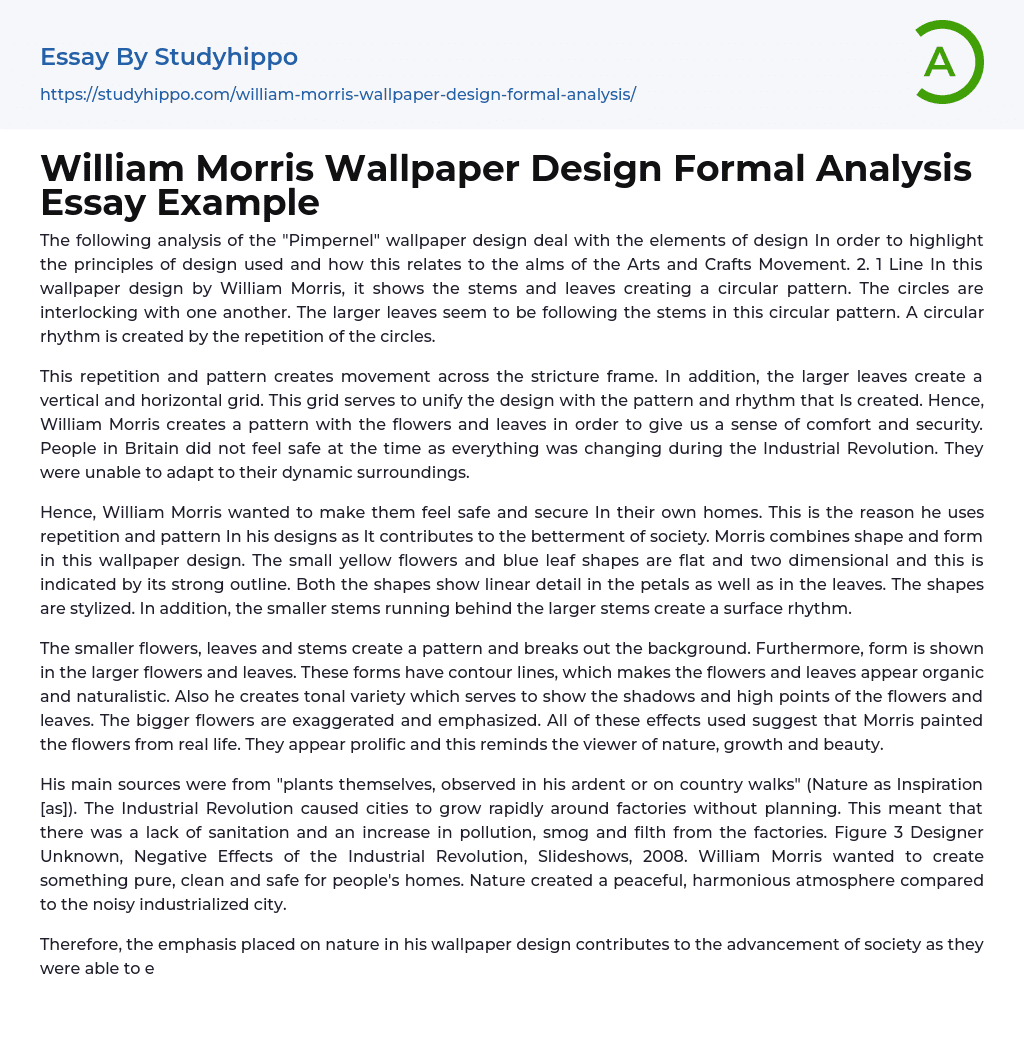The following analysis of the "Pimpernel" wallpaper design deal with the elements of design In order to highlight the principles of design used and how this relates to the alms of the Arts and Crafts Movement. 2. 1 Line In this wallpaper design by William Morris, it shows the stems and leaves creating a circular pattern. The circles are interlocking with one another. The larger leaves seem to be following the stems in this circular pattern. A circular rhythm is created by the repetition of the circles.
This repetition and pattern creates movement across the stricture frame. In addition, the larger leaves create a vertical and horizontal grid. This grid serves to unify the design with the pattern and rhythm that Is created. Hence, William Morris creates a pattern with the flowers and leaves in order
...to give us a sense of comfort and security. People in Britain did not feel safe at the time as everything was changing during the Industrial Revolution. They were unable to adapt to their dynamic surroundings.
Hence, William Morris wanted to make them feel safe and secure In their own homes. This is the reason he uses repetition and pattern In his designs as It contributes to the betterment of society. Morris combines shape and form in this wallpaper design. The small yellow flowers and blue leaf shapes are flat and two dimensional and this is indicated by its strong outline. Both the shapes show linear detail in the petals as well as in the leaves. The shapes are stylized. In addition, the smaller stems running behind the larger stems create a surface rhythm.
The smaller flowers, leave
and stems create a pattern and breaks out the background. Furthermore, form is shown in the larger flowers and leaves. These forms have contour lines, which makes the flowers and leaves appear organic and naturalistic. Also he creates tonal variety which serves to show the shadows and high points of the flowers and leaves. The bigger flowers are exaggerated and emphasized. All of these effects used suggest that Morris painted the flowers from real life. They appear prolific and this reminds the viewer of nature, growth and beauty.
His main sources were from "plants themselves, observed in his ardent or on country walks" (Nature as Inspiration [as]). The Industrial Revolution caused cities to grow rapidly around factories without planning. This meant that there was a lack of sanitation and an increase in pollution, smog and filth from the factories. Figure 3 Designer Unknown, Negative Effects of the Industrial Revolution, Slideshows, 2008. William Morris wanted to create something pure, clean and safe for people's homes. Nature created a peaceful, harmonious atmosphere compared to the noisy industrialized city.
Therefore, the emphasis placed on nature in his wallpaper design contributes to the advancement of society as they were able to escape the filth and pollution outside of their houses and focus on the natural aspects of the wallpaper within the comfort of their homes. In addition, his design also shows a link between arts and crafts. Art deals with fine arts and the ability to draw objects the way they are seen. However, craft refers to representing objects in a more simplified way. The combination of the shape and form in this wallpaper design creates a pattern which
s safe and secure.
Therefore, this also contributes to the betterment of society. 2. 3 Color and tone In this design, Morris uses lighter colors on a dark background. The color contrast between the light yellow flowers and light blue leaves directs the eye and creates a horizontal pattern. He uses tonal variation for the large forms, such as the big green flowers and leaves, of the design in order to create emphasis and contrast. This adds to the circular movement created by the leaves and stems. The colors used also create a surface pattern.
- Aesthetics essays
- Art History essays
- Artist essays
- ballet essays
- Body Art essays
- Color essays
- Concert Review essays
- Creativity essays
- Cultural Anthropology essays
- Ethnography essays
- Harlem Renaissance essays
- Heritage essays
- Modernism essays
- Mona Lisa essays
- Pastoral essays
- Postmodernism essays
- Realism essays
- Symbolism essays
- Theatre essays
- Visual Arts essays
- Voice essays
- Work of art essays
- Architecture essays
- Design essays
- Graffiti essays
- Graphic essays
- Interior design essays
- Painting essays
- Photography essays
- Sculpture essays
- Typography essays




